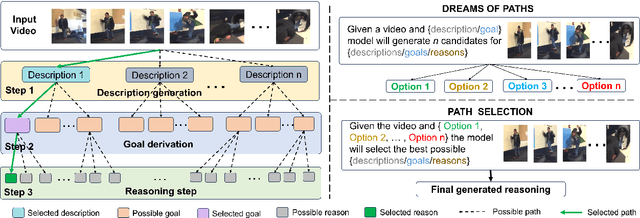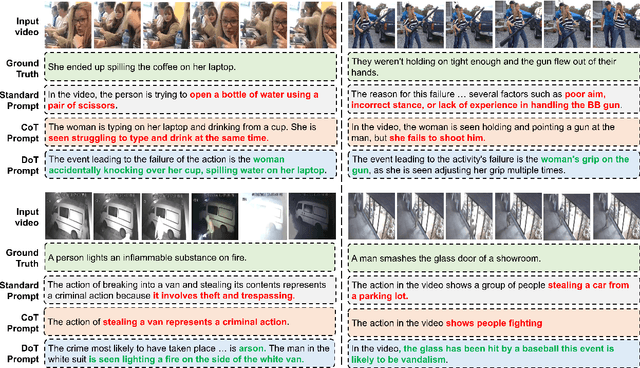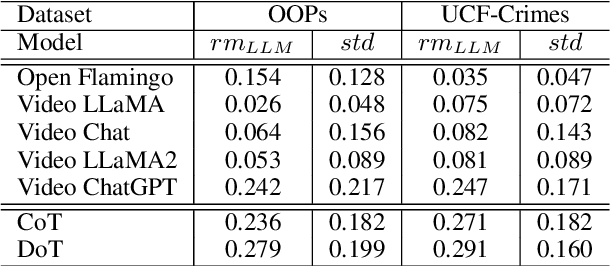Yogesh S Rawat
Re:Verse -- Can Your VLM Read a Manga?
Aug 11, 2025Abstract:Current Vision Language Models (VLMs) demonstrate a critical gap between surface-level recognition and deep narrative reasoning when processing sequential visual storytelling. Through a comprehensive investigation of manga narrative understanding, we reveal that while recent large multimodal models excel at individual panel interpretation, they systematically fail at temporal causality and cross-panel cohesion, core requirements for coherent story comprehension. We introduce a novel evaluation framework that combines fine-grained multimodal annotation, cross-modal embedding analysis, and retrieval-augmented assessment to systematically characterize these limitations. Our methodology includes (i) a rigorous annotation protocol linking visual elements to narrative structure through aligned light novel text, (ii) comprehensive evaluation across multiple reasoning paradigms, including direct inference and retrieval-augmented generation, and (iii) cross-modal similarity analysis revealing fundamental misalignments in current VLMs' joint representations. Applying this framework to Re:Zero manga across 11 chapters with 308 annotated panels, we conduct the first systematic study of long-form narrative understanding in VLMs through three core evaluation axes: generative storytelling, contextual dialogue grounding, and temporal reasoning. Our findings demonstrate that current models lack genuine story-level intelligence, struggling particularly with non-linear narratives, character consistency, and causal inference across extended sequences. This work establishes both the foundation and practical methodology for evaluating narrative intelligence, while providing actionable insights into the capability of deep sequential understanding of Discrete Visual Narratives beyond basic recognition in Multimodal Models.
DisenQ: Disentangling Q-Former for Activity-Biometrics
Jul 09, 2025Abstract:In this work, we address activity-biometrics, which involves identifying individuals across diverse set of activities. Unlike traditional person identification, this setting introduces additional challenges as identity cues become entangled with motion dynamics and appearance variations, making biometrics feature learning more complex. While additional visual data like pose and/or silhouette help, they often struggle from extraction inaccuracies. To overcome this, we propose a multimodal language-guided framework that replaces reliance on additional visual data with structured textual supervision. At its core, we introduce \textbf{DisenQ} (\textbf{Disen}tangling \textbf{Q}-Former), a unified querying transformer that disentangles biometrics, motion, and non-biometrics features by leveraging structured language guidance. This ensures identity cues remain independent of appearance and motion variations, preventing misidentifications. We evaluate our approach on three activity-based video benchmarks, achieving state-of-the-art performance. Additionally, we demonstrate strong generalization to complex real-world scenario with competitive performance on a traditional video-based identification benchmark, showing the effectiveness of our framework.
Coarse Attribute Prediction with Task Agnostic Distillation for Real World Clothes Changing ReID
May 19, 2025Abstract:This work focuses on Clothes Changing Re-IDentification (CC-ReID) for the real world. Existing works perform well with high-quality (HQ) images, but struggle with low-quality (LQ) where we can have artifacts like pixelation, out-of-focus blur, and motion blur. These artifacts introduce noise to not only external biometric attributes (e.g. pose, body shape, etc.) but also corrupt the model's internal feature representation. Models usually cluster LQ image features together, making it difficult to distinguish between them, leading to incorrect matches. We propose a novel framework Robustness against Low-Quality (RLQ) to improve CC-ReID model on real-world data. RLQ relies on Coarse Attributes Prediction (CAP) and Task Agnostic Distillation (TAD) operating in alternate steps in a novel training mechanism. CAP enriches the model with external fine-grained attributes via coarse predictions, thereby reducing the effect of noisy inputs. On the other hand, TAD enhances the model's internal feature representation by bridging the gap between HQ and LQ features, via an external dataset through task-agnostic self-supervision and distillation. RLQ outperforms the existing approaches by 1.6%-2.9% Top-1 on real-world datasets like LaST, and DeepChange, while showing consistent improvement of 5.3%-6% Top-1 on PRCC with competitive performance on LTCC. *The code will be made public soon.*
A Large-Scale Analysis on Contextual Self-Supervised Video Representation Learning
Apr 08, 2025Abstract:Self-supervised learning has emerged as a powerful paradigm for label-free model pretraining, particularly in the video domain, where manual annotation is costly and time-intensive. However, existing self-supervised approaches employ diverse experimental setups, making direct comparisons challenging due to the absence of a standardized benchmark. In this work, we establish a unified benchmark that enables fair comparisons across different methods. Additionally, we systematically investigate five critical aspects of self-supervised learning in videos: (1) dataset size, (2) model complexity, (3) data distribution, (4) data noise, and (5) feature representations. To facilitate this study, we evaluate six self-supervised learning methods across six network architectures, conducting extensive experiments on five benchmark datasets and assessing performance on two distinct downstream tasks. Our analysis reveals key insights into the interplay between pretraining strategies, dataset characteristics, pretext tasks, and model architectures. Furthermore, we extend these findings to Video Foundation Models (ViFMs), demonstrating their relevance in large-scale video representation learning. Finally, leveraging these insights, we propose a novel approach that significantly reduces training data requirements while surpassing state-of-the-art methods that rely on 10% more pretraining data. We believe this work will guide future research toward a deeper understanding of self-supervised video representation learning and its broader implications.
DIFFER: Disentangling Identity Features via Semantic Cues for Clothes-Changing Person Re-ID
Mar 28, 2025



Abstract:Clothes-changing person re-identification (CC-ReID) aims to recognize individuals under different clothing scenarios. Current CC-ReID approaches either concentrate on modeling body shape using additional modalities including silhouette, pose, and body mesh, potentially causing the model to overlook other critical biometric traits such as gender, age, and style, or they incorporate supervision through additional labels that the model tries to disregard or emphasize, such as clothing or personal attributes. However, these annotations are discrete in nature and do not capture comprehensive descriptions. In this work, we propose DIFFER: Disentangle Identity Features From Entangled Representations, a novel adversarial learning method that leverages textual descriptions to disentangle identity features. Recognizing that image features inherently mix inseparable information, DIFFER introduces NBDetach, a mechanism designed for feature disentanglement by leveraging the separable nature of text descriptions as supervision. It partitions the feature space into distinct subspaces and, through gradient reversal layers, effectively separates identity-related features from non-biometric features. We evaluate DIFFER on 4 different benchmark datasets (LTCC, PRCC, CelebreID-Light, and CCVID) to demonstrate its effectiveness and provide state-of-the-art performance across all the benchmarks. DIFFER consistently outperforms the baseline method, with improvements in top-1 accuracy of 3.6% on LTCC, 3.4% on PRCC, 2.5% on CelebReID-Light, and 1% on CCVID. Our code can be found here.
STPro: Spatial and Temporal Progressive Learning for Weakly Supervised Spatio-Temporal Grounding
Feb 28, 2025



Abstract:In this work we study Weakly Supervised Spatio-Temporal Video Grounding (WSTVG), a challenging task of localizing subjects spatio-temporally in videos using only textual queries and no bounding box supervision. Inspired by recent advances in vision-language foundation models, we investigate their utility for WSTVG, leveraging their zero-shot grounding capabilities. However, we find that a simple adaptation lacks essential spatio-temporal grounding abilities. To bridge this gap, we introduce Tubelet Referral Grounding (TRG), which connects textual queries to tubelets to enable spatio-temporal predictions. Despite its promise, TRG struggles with compositional action understanding and dense scene scenarios. To address these limitations, we propose STPro, a novel progressive learning framework with two key modules: (1) Sub-Action Temporal Curriculum Learning (SA-TCL), which incrementally builds compositional action understanding, and (2) Congestion-Guided Spatial Curriculum Learning (CG-SCL), which adapts the model to complex scenes by spatially increasing task difficulty. STPro achieves state-of-the-art results on three benchmark datasets, with improvements of 1.0% on VidSTG-Declarative and 3.0% on HCSTVG-v1.
LR0.FM: Low-Resolution Zero-shot Classification Benchmark For Foundation Models
Feb 07, 2025Abstract:Visual-language foundation Models (FMs) exhibit remarkable zero-shot generalization across diverse tasks, largely attributed to extensive pre-training on largescale datasets. However, their robustness on low-resolution/pixelated (LR) images, a common challenge in real-world scenarios, remains underexplored. We introduce LR0.FM, a comprehensive benchmark evaluating the impact of low resolution on the zero-shot classification performance of 10 FM(s) across 66 backbones and 15 datasets. We propose a novel metric, Weighted Aggregated Robustness, to address the limitations of existing metrics and better evaluate model performance across resolutions and datasets. Our key findings show that: (i) model size positively correlates with robustness to resolution degradation, (ii) pre-training dataset quality is more important than its size, and (iii) fine-tuned and higher resolution models are less robust against LR. Our analysis further reveals that the model makes semantically reasonable predictions at LR, and the lack of fine-grained details in input adversely impacts the model's initial layers more than the deeper layers. We use these insights and introduce a simple strategy, LR-TK0, to enhance the robustness of models without compromising their pre-trained weights. We demonstrate the effectiveness of LR-TK0 for robustness against low-resolution across several datasets and its generalization capability across backbones and other approaches. Code is available at https://github.com/shyammarjit/LR0.FM
DH-Bench: Probing Depth and Height Perception of Large Visual-Language Models
Aug 21, 2024



Abstract:Geometric understanding is crucial for navigating and interacting with our environment. While large Vision Language Models (VLMs) demonstrate impressive capabilities, deploying them in real-world scenarios necessitates a comparable geometric understanding in visual perception. In this work, we focus on the geometric comprehension of these models; specifically targeting the depths and heights of objects within a scene. Our observations reveal that, although VLMs excel in basic geometric properties perception such as shape and size, they encounter significant challenges in reasoning about the depth and height of objects. To address this, we introduce a suite of benchmark datasets encompassing Synthetic 2D, Synthetic 3D, and Real-World scenarios to rigorously evaluate these aspects. We benchmark 17 state-of-the-art VLMs using these datasets and find that they consistently struggle with both depth and height perception. Our key insights include detailed analyses of the shortcomings in depth and height reasoning capabilities of VLMs and the inherent bias present in these models. This study aims to pave the way for the development of VLMs with enhanced geometric understanding, crucial for real-world applications. The code and datasets for our benchmarks will be available at \url{https://tinyurl.com/DH-Bench1}.
AirSketch: Generative Motion to Sketch
Jul 12, 2024Abstract:Illustration is a fundamental mode of human expression and communication. Certain types of motion that accompany speech can provide this illustrative mode of communication. While Augmented and Virtual Reality technologies (AR/VR) have introduced tools for producing drawings with hand motions (air drawing), they typically require costly hardware and additional digital markers, thereby limiting their accessibility and portability. Furthermore, air drawing demands considerable skill to achieve aesthetic results. To address these challenges, we introduce the concept of AirSketch, aimed at generating faithful and visually coherent sketches directly from hand motions, eliminating the need for complicated headsets or markers. We devise a simple augmentation-based self-supervised training procedure, enabling a controllable image diffusion model to learn to translate from highly noisy hand tracking images to clean, aesthetically pleasing sketches, while preserving the essential visual cues from the original tracking data. We present two air drawing datasets to study this problem. Our findings demonstrate that beyond producing photo-realistic images from precise spatial inputs, controllable image diffusion can effectively produce a refined, clear sketch from a noisy input. Our work serves as an initial step towards marker-less air drawing and reveals distinct applications of controllable diffusion models to AirSketch and AR/VR in general.
Navigating Hallucinations for Reasoning of Unintentional Activities
Mar 03, 2024



Abstract:In this work we present a novel task of understanding unintentional human activities in videos. We formalize this problem as a reasoning task under zero-shot scenario, where given a video of an unintentional activity we want to know why it transitioned from intentional to unintentional. We first evaluate the effectiveness of current state-of-the-art Large Multimodal Models on this reasoning task and observe that they suffer from hallucination. We further propose a novel prompting technique,termed as Dream of Thoughts (DoT), which allows the model to navigate through hallucinated thoughts to achieve better reasoning. To evaluate the performance on this task, we also introduce three different specialized metrics designed to quantify the models reasoning capability. We perform our experiments on two different datasets, OOPs and UCF-Crimes, and our findings show that DOT prompting technique is able to outperform standard prompting, while minimizing hallucinations.
 Add to Chrome
Add to Chrome Add to Firefox
Add to Firefox Add to Edge
Add to Edge